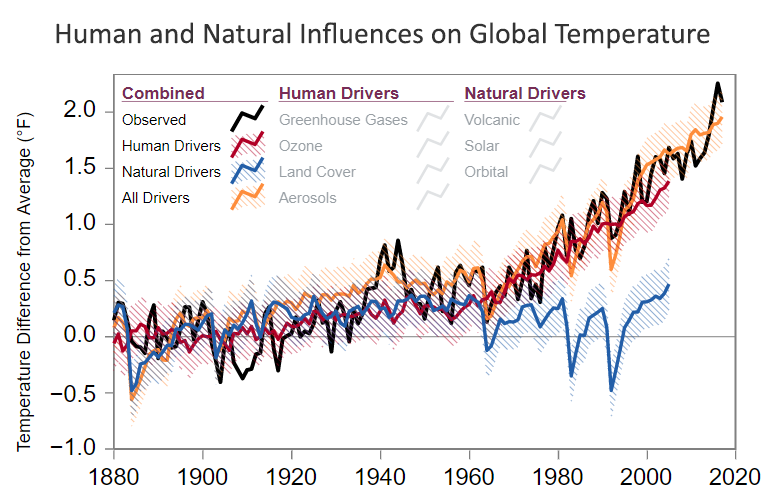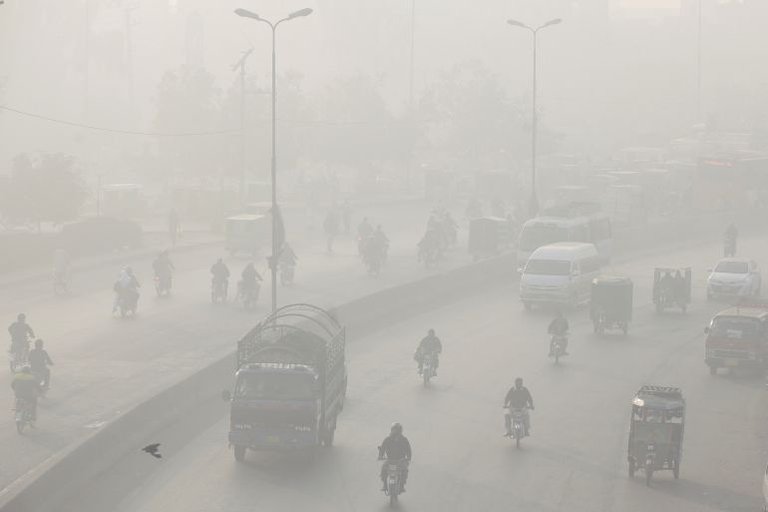Climate change in Pakistan
Climate change:
Climate change refers to long-term shifts in temperatures and weather patterns. Such shifts can be natural, due to changes in the sun’s activity or large volcanic eruptions.

https://www.pakistantoday.com.pk/2023/12/23/eco-friendly-strategies-to-combat-climate-change-are-urgent/
•History of climate change science:
The history of the scientific discovery of climate change began in the early 19th century when ice ages and other natural changes in paleoclimate were first suspected and the natural greenhouse effect was first identified. In the late 19th century, scientists first argued that human emissions of greenhouse gases could change Earth's energy balance and climate.The existence of the greenhouse effect, while not named as such, was proposed as early as 1824 by Joseph Fourier.The argument and the evidence were further strengthened by Claude Pouillet in 1827 and 1838. In 1856 Eunice Newton Foote demonstrated that the warming effect of the sun is greater for air with water vapour than for dry air and the effect is even greater with carbon dioxide.
•Causes of climate change

https://www.epa.gov/climatechange-science/causes-climate-change
•Causes of climate change:
Burning fossil fuels, cutting down forests and farming livestock are increasingly influencing the climate and the earth’s temperature.
This adds enormous amounts of greenhouse gases to those naturally occurring in the atmosphere, increasing the greenhouse effect and global warming.
•Eample:
•Burning coal, oil and gas
produces carbon dioxide and nitrous oxide.
•Cutting down forests /deforestation.
Trees help to regulate the climate by absorbing CO2 from the atmosphere. When they are cut down, that beneficial effect is lost and the carbon stored in the trees is released into the atmosphere, adding to the greenhouse effect.
Increasing livestock farming
Cows and sheep produce large amounts of methane when they digest their food.
•Fertilisers containing nitrogen
produce nitrous oxide emissions.
Fluorinated gases are emitted from equipment and products that use these gases. Such emissions have a very strong warming effect, up to 23 000 times greater

https://climate.ec.europa.eu/climate-change/causes-climate-change_en
•Climate change in Pakistan:
Pakistan is grappling with the profound impacts of climate change, such as shifting weather patterns and catastrophic floods. Unfortunately, these impacts are projected to escalate, with forecasts suggesting that climate-related events, environmental degradation, and air pollution may cause Pakistan GDP to shrink by 18-20% by 2050. This alarming statistic underscores the need to address climate change and mitigate its effects on people and their livelihoods. Even though developing countries like Pakistan may not be the primary contributors to climate change, acknowledging and confronting its fallout is indispensable, especially for combatting pressing local issues like air pollution and smog.
• Causes:
Climate change in Pakistan is a major issue for the country. Pakistan is highly vulnerable to climate change. As with the changing climate in South Asia as a whole, the climate of Pakistan has changed over the past several decades, with significant impacts on the environment and people.In addition to increased heat, drought and extreme weather in parts of the country, the melting of glaciers in the Himalayas has impacted some of the important rivers of Pakistan. Between 1999 and 2018, Pakistan ranked 5th in the countries affected by extreme weather caused by climate change.Pakistan is prone to a range of natural disasters, including cyclones, floods, drought, intense rainfall, and earthquakes. According to scientific research, climate change played a substantial role in the devastating floods of 2022, which had a direct impact on over 30 million people in Pakistan, resulting in the loss of lives, damage to public infrastructure, and displacement from homes.Climate change poses a significant menace to Pakistan's economy and security.
•Most polluted city due to climate change:
This past month Lahore Pakistan has repeatedly topped the daily ranking of most polluted city in the world. Pollution and winter weather conditions combine to shroud the city in smog disrupting flights, causing major road closures, and wreaking havoc on the health of its citizenry.
The problem of air pollution has been steadily growing in Lahore and many other cities in Punjab province. Punjab is the most populous province in Pakistan with an estimated population of 110 million people. Five cities in Punjab were listed among the 50 most polluted cities in the world in 2020.The situation in other major Pakistani cities, such as the coastal megalopolis of Karachi, is not much better. Yet, the current situation in Lahore is most alarming, with its fine particulate count repeatedly rising well above 40 times the World Health Organization’s air quality guideline values.
Prolonged or heavy exposure to hazardous air causes varied health complications, including asthma,lung damage, bronchial infections, strokes,heart problems, and shortened life expectancy.The Global Alliance on Health and Pollution estimated in 2019 that 128,000 Pakistanis die annually due to air pollution-related illnesses.Decision-makers have been slow to react to the pollution problem. In 2019, Pakistan’s minister of climate change infamously dubbed growing concern about the smog problem in Lahore as being a
conspiratorial attempt to spread misinformation. Many officials and politicians continue blaming stubble burning by Indian farmers as the main cause for Lahore’s smog problem.Blaming India may be a tit-for-tat response to similar Indian accusations,but it not an accurate assessment. Ever-changing wind patterns during the stubble-burning season mean wind directions keep fluctuating across the India-Pakistan border.“The smog in Lahore is caused by a confluence of metrological and anthropogenic factors,”said Saleem Ali, a member of the United Nations International Resource Panel.Namely, temperature inversion traps pollution in the atmosphere, which alongside seasonal crop burning on the Indian-Pakistani border combines with other sources of year-round pollution and fog to cause a spike in pollution and winter smog.
https://foreignpolicy.com/2021/11/29/pakistan-lahore-pollution-fossil-fuels-climate/

Sources of Image
• How to overcome the pollution of this city?
To overcome the issue of pollution in Lahore, it requires collective efforts from the government, communities, and individuals. Here are a few steps that can help:
- Promote sustainable transportation: Encourage the use of public transport, carpooling, and cycling to reduce vehicular emissions.
- Improve industrial practices: Implement stricter regulations on industrial emissions and promote the use of cleaner technologies.
- Enhance waste management: Implement proper waste disposal and recycling systems to reduce the burning of solid waste, which contributes to air pollution.
- Plant more trees: Increase green spaces and urban forestry to improve air quality and reduce the impact of pollution.
- Raise awareness: Educate the public about the causes and effects of pollution and encourage responsible behavior, such as reducing personal carbon footprint and practicing eco-friendly habits.
- Support renewable energy: Promote the use of renewable energy sources like solar and wind power to reduce reliance on fossil fuels.
- Strengthen environmental policies: Enforce strict environmental regulations and ensure their effective implementation to hold polluters accountable.
Downvoted for plagiarism which I suggested in your intro that you obviously did not read, or you would not repeat the plagiarism. Your post should have 20% source text maximum, this one has way over 50% copy/pasted.
If you were as educated as you stated in the intro post, then write your own material and you would fare much better in the long run.
All you are doing is making money on someone else's information this way, not good, and it won't last long.
Sorry next will try to avoid to copy resources